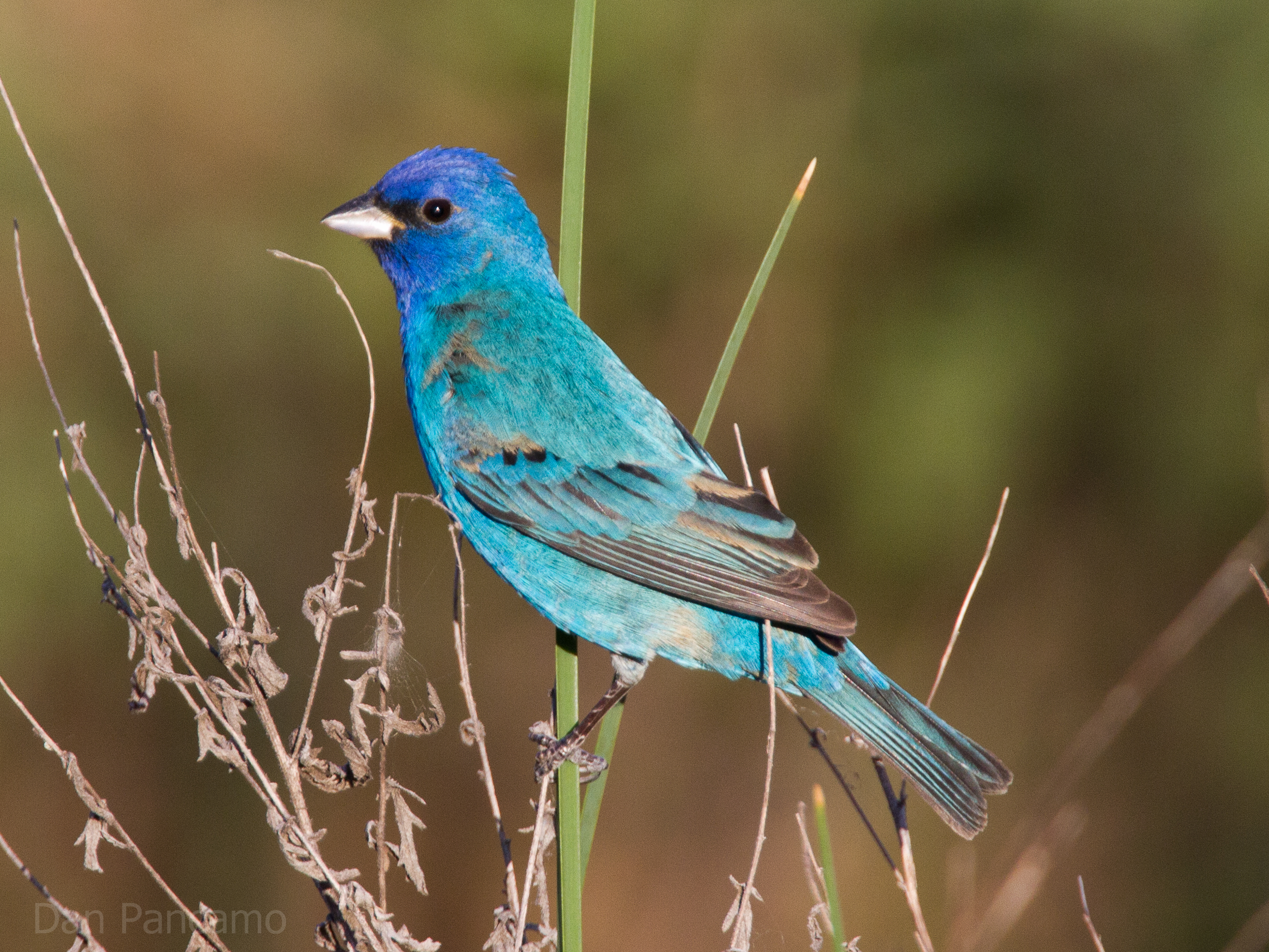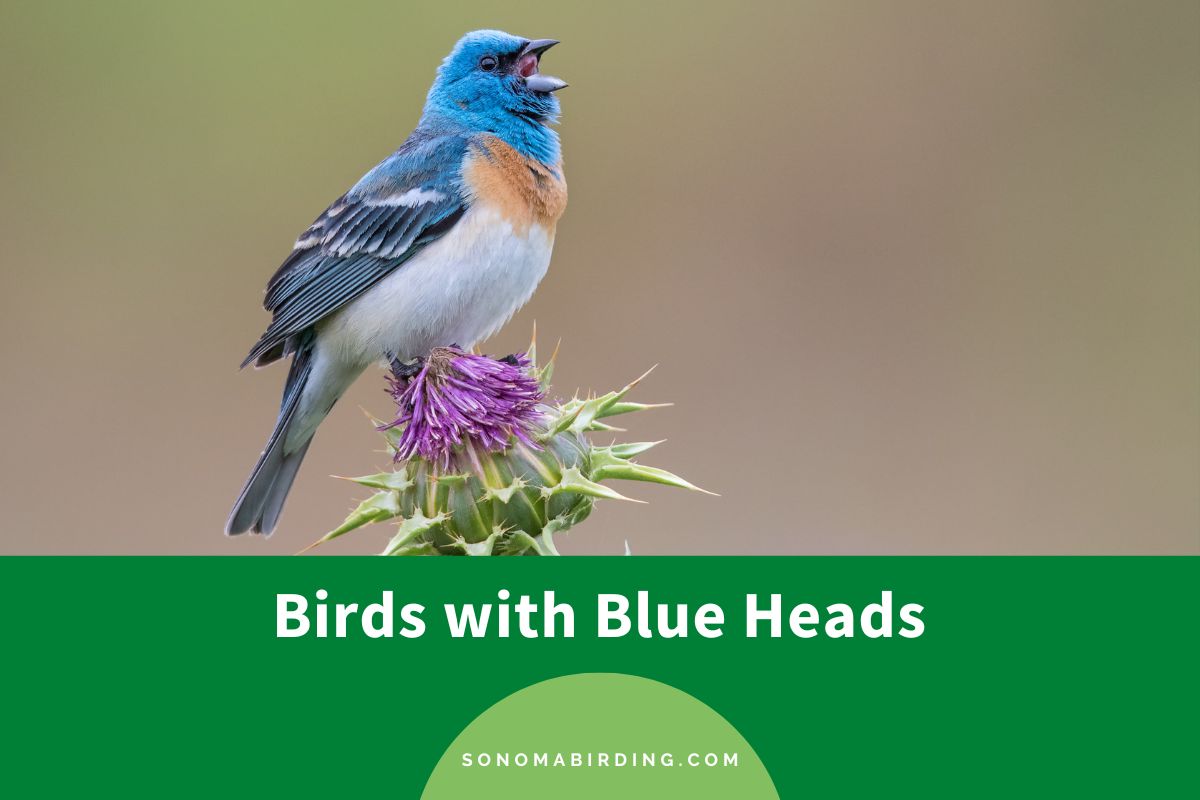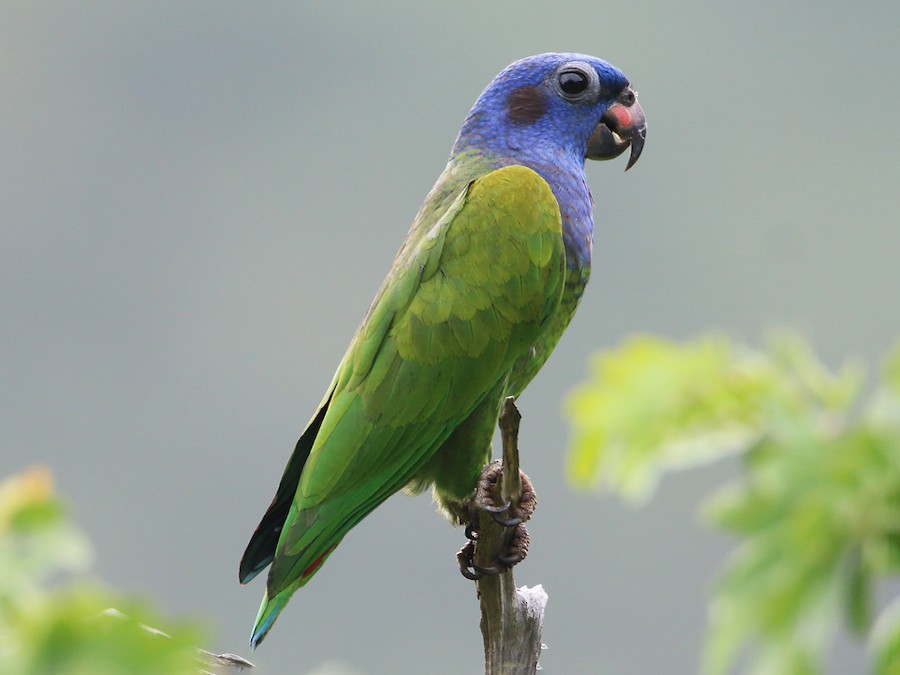Whether it’s due to natural or sexual selection, there are potentially hundreds of bird species across the world that have blue heads. This phenomenon, where you see different species displaying similar or identical traits despite being in different locations, is known as convergent evolution. You can see this in blue-colored heads and almost any other trait.
In this article, we’ll be going over 20 common bird species with blue heads that you may find all over the world. Being able to find these birds in so many places is certainly part of what makes convergent evolution so special.
1. Lazuli Bunting

Scientific Name: Passerina amoena
Range: Southern Canada, midwestern and western United States, Mexico
The lazuli bunting is a songbird in which the breeding males have a solid blue color above with white wingbars, a white belly, and an orange breast. Females are of a buffy brown color with lighter-colored wingbars and somewhat more orange breasts.
Compared to the Indigo Bunting females, the lazuli bunting females lack the streaks on the underside and have bolder wingbars, brighter breasts, and a less contrasting pale throat.
Lazuli buntings mainly inhabit shrubby areas in forested zones, such as on hillsides and other semi-open habitats. They mainly gather together in weedy fields in Mexico during the winter.
The lazuli bunting’s diet mainly consists of seeds and insects. Over half of their summer diet is made up of insects, such as grasshoppers, caterpillars, beetles, and ants. This changes to mainly seeds, such as those from grasses, weed seeds, and waste grain, in the winter.
2. Purple Sunbird
Scientific Name: Cinnyris asiaticus
Range: Iran, Saudi Arabia, Oman, India, Thailand, Myanmar, Vietnam, Nepal, Pakistan
The purple sunbird consists of an iridescent blue and purple plumage overall with maroon-colored feathers on the breast for breeding males.
Nonbreeding males are mainly an olive-brown color with black upperparts and yellow underparts with a blue-black band running across the throat and chest. Females appear somewhat similar to nonbreeding males in that they also have olive plumage above and yellow below.
The purple sunbird is found mainly in thin deciduous forests and gardens, including gardens found in more centralized urban areas.
The purple sunbird, like other sunbird species, feeds mainly on nectar, though they will also complement their diet with insects, usually when feeding their young. They tend to perch rather than hover (like hummingbirds) when feeding on nectar.
3. Western Bluebird
Scientific Name: Sialia mexicana
Range: Southwestern Canada, western United States, Mexico
The western bluebird is a small thrush in which adult males have a dark blue head, back, and wings, with dark orange breasts and sides that sometimes may extend to the back. Females are a gray color overall with some orange on the breasts; the blue plumage can only be found on the wings and tail.
The western bluebird’s habitat usually consists of open woodlands, woodland edges, and fields that contain some scattered trees. They nest in tree cavities and can be found perched on a tree branch or fencepost.
The western bluebird feeds primarily on insects and berries. Insects, such as grasshoppers, caterpillars, beetles, ants, and others, make up the majority of their diet, especially during the summer. Berries and small fruits, such as those from mistletoe, juniper, and elderberry, are eaten mainly during the winter months.
4. Common Grackle
Scientific Name: Quiscalus quiscula
Range: North America (besides Alaska)
The common grackle is a slender and glossy blackbird with pale yellow eyes, a long, sturdy beak, and a navy-blue iridescent head. Females are overall slimmer than males, particularly around the neck, nape, and back. They are larger than a jay but smaller than a crow, with proportionally longer tails and shorter wings.
Typical habitats for the common grackle include wet and open woodlands, marshes, and more urban areas such as suburban backyards, parks, and agricultural fields. They forage in the fields, scrubby areas, and open woods, while they’re also common visitors to bird feeders.
The common grackle has quite an extensive diet including, but not limited to, insects (i.e. grasshoppers, caterpillars, beetle grubs), spiders, earthworms, millipedes, crops (mainly corn), sunflower seeds, acorns, and sweetgum.
5. Satin Bowerbird
Scientific Name: Ptilonorhynchus violaceus
Range: Southeastern Australia
The satin bowerbird is a large stout bowerbird that, for adult males, consists entirely of dark blue-purple plumage, a pale beak, and bright violet eyes. Adult females and juveniles are mainly green and brown in color, with blue or pink eyes and spotted underparts.
The satin bowerbird prefers to inhabit humid rainforests, eucalypt forests, woodlands, their edges, and along adjacent open areas in southeastern Australia.
The satin bowerbird feeds mainly on fruit, flowers, seeds, berries, leaves, and nectar throughout the year but will include a decent number of insects in its diet during the summer breeding months. Plant matter, especially leaves, account for their entire diet during the winter.
6. Tree Swallow
Scientific Name: Tachycineta bicolor
Range: North and Central America
The tree swallow is a medium-sized swallow with adult males having iridescent blue-green plumage above and white plumage below. Females and juveniles also have white plumage below, but their upper parts are of a duller brown color with some or no iridescence. They are overall compact, have large broad wings, and have a somewhat notched tail.
Tree swallows may be found in various open habitats, such as grassy fields, lakes, marshes, flooded meadows, streams, and other open areas near woods. They breed in natural and manmade cavities.
The tree swallow feeds mainly on insects, such as flies, beetles, winged ants, and others, during the summer. Other prey includes spiders and small crustaceans. About 20% of their annual diet consists of plant matter, which is usually consumed in the winter.
7. Blue-Headed Vireo
Scientific Name: Vireo solitarius
Range: Canada, midwestern to eastern United States, Central America
The blue-headed vireo is a colorful vireo with white patches around the eyes, a dark blue-gray head, pale yellow sides, and bright white wingbars. Appears similar to the Cassin’s Vireo, but the blue-headed vireo is more colorful and has higher contrasts in color, such as that between the dark gray face and white throat.
The blue-headed vireo breeds in forested areas, such as forests with mixed coniferous and deciduous trees. The migrants may be found in most wooded areas, especially those that contain understory plants.
The blue-headed vireo’s diet consists mainly of insects, such as moths, butterflies, stinkbugs, dragonflies, grasshoppers, crickets, and others, as well as their larvae. Other food sources include spiders, snails, and some small fruits and fleshy berries, the latter two they usually feed on during the winter.
8. Indigo Bunting

Scientific Name: Passerina cyanea
Range: Southern Canada, United States, Central America
The indigo bunting is a small seed-eating bird with breeding males being completely blue with a somewhat deeper blue head. Females are of a plain brown color with a white throat, blue tail, and pale streaks on the underparts.
Compared with the female Lazuli bunting, the female indigo bunting tends to have more streaks on the underparts, as well as fainter wingbars, paler breasts, and a more contrasted white throat.
The indigo bunting tends to breed in brushy and weedy habitats adjacent to farmed land, woods, roads, powerlines, railways, and riparian habitats. They may also breed in deciduous woodland clearings, in some weedy or abandoned agricultural fields, and near swamps. They tend to gather in flocks in weedy fields, especially during the winter.
The diet of the indigo bunting consists mainly of seeds and insects. Insects, spiders, seeds, and berries are fed during breeding seasons, while the young are fed mainly insects. This changes to include mainly seeds during the winter, though occasional insects may also be found.
9. Barn Swallow

Scientific Name: Hirundo rustica
Range: Worldwide, besides Australia, Russia, the Arctic, and Antarctica
The barn swallow is a large and colorful swallow, with a long, forked tail, dark rump, a bright orange throat and forehead, and iridescent navy-blue plumage above. Underpart coloration may vary depending on the range, with some being a bright orange color and others having a white color.
The barn swallow can be seen in any open habitat, such as large fields and wetlands. They tend to nest close to human habitation, where they’ll often build a muddy cup nest in a barn or under some type of dock.
The typical diet for the barn swallow includes insects, such as moths, flies, crickets, beetles, and grasshoppers. They are strictly insectivores but will occasionally supplement their diet with a small amount of grit or eggshells to help with digestion.
10. Cerulean Warbler

Scientific Name: Setophaga cerulea
Range: Midwestern to eastern United States, southern Central America, northern South America
The cerulean warbler is a light-blue warbler with a white throat and belly, a thin necklace, and dark stripes on the sides. Females have a light turquoise plumage with pale eyebrows and blurry streaks on the sides. Juveniles will have a yellow wash on the underparts, while all cerulean warblers have bright white wing bars.
Cerulean warblers tend to stay in the high canopy of mature deciduous forests, especially in riparian areas or dry mountain ridge-tops. They can usually be spotted on the eastern side of the Andes during the winter. Because of their tendency to stay at high altitude locations, the cerulean warbler’s blue coloration can be difficult to spot.
Cerulean warblers are insectivores that consume mainly insect larvae and winged insects but will also consume beetles, weevils, and caterpillars if possible. They may eat some plant material during the winter when insect populations are low.
11. Black-Throated Blue Warbler
Scientific Name: Setophaga caerulescens
Range: Southern Canada, United States, rarely in Mexico
The black-throated blue warbler is a contrasting warbler that displays clear sexual dimorphism, with males having a dark blue plumage above with a black face, sides, and white belly, and females having plain brown-olive plumage and pale yellowish-brown underparts with a subtle face pattern. Both sexes have small white patches on the wings, with only the dull juvenile females lacking them.
The black-throated blue warbler breeds in the understory of mixed forests, especially on hills with dense vegetation. During migration, they may be found in almost any wooded or shrubby habitat.
During most of the year, the black-throated blue warbler feeds on spiders, flies, and caterpillars, which they gather from leaves and twigs. They then supplement their diet with different fruits during the winter.
12. Woodhouse’s Scrub-Jay
Scientific Name: Aphelocoma woodhouseii
Range: Southwestern United States, Mexico
The Woodhouse’s Scrub-jay is a brilliant jay consisting of a royal blue plumage above with a gray-brown back and gray underparts. Compared with the California Scrub-Jay, the woodhouse’s Scrub-jay is paler and has a more gradual contrast with a diffuse blue breast strip.
The Woodhouse’s Scrub-jay is native to oak woodlands and pinon-juniper forests but can also be found visiting suburban backyards and bird feeders.
The Woodhouse’s Scrub-jay’s diet consists mainly of insects and fruit during the spring and summer and nuts and seeds during the fall and winter. They may also eat small animals, such as lizards, spiders, snails, and other juvenile birds, in which they find their nests by following the parent birds.
13. Eastern Bluebird
Scientific Name: Sialia sialis
Range: North America (Besides Alaska), Central America
The eastern bluebird is a small migratory thrush with adult males having royal blue plumage above with a bright orange throat and breast, with a similarly bright white belly. Females are paler in general, with a grayish-orange color on the breast and sides of the neck, along with a white belly.
The eastern bluebird’s habitats include open country with patchy vegetation and large trees. Examples include meadows, old fields, and more urban areas such as golf courses. They can be found perched on wires or fence posts, or nested in cavities.
The eastern bluebird mainly feeds on insects (i.e. crickets, grasshoppers, beetles, etc.), fruit, and berries. They are sometimes seen feeding on larger animals as well, such as shrews, salamanders, snakes, lizards, and tree frogs.
14. Shining Honeycreeper
Scientific Name: Cyanerpes lucidus
Range: Central America (Besides Mexico)
The shining honeycreeper is a small tanager that resembles a warbler. Males are of a deep blue color overall with black throats and wings, while females have a row of bluish streaks across the chest. They have a more curved beak and shorter tail than the red-legged honeycreeper, along with yellow legs that make them stand out among other similar species.
The shining honeycreeper’s habitat includes foothills and their adjacent lowlands, including humid evergreen forests and forest edges. They may be found feeding in the canopies of fruiting and flowering trees or bushes.
The shining honeycreeper’s diet consists of fruit, insects, and nectar. Insects are taken from vines and twigs, as well as from the air or from under dead leaves.
15. Blue-Headed Parrot
Scientific Name: Pionus menstruus
Range: Southern Central America, northern and central South America
The blue-headed parrot is a medium-sized parrot with a short square tail, a green body with a blue head, and red undertail coverts. Sexes have a similar appearance, hence they’re rather easily distinguishable if given a clear viewing.
The blue-headed parrot inhabits mainly forest and semi-open countries, including cultivated areas. They are native to the tropical and subtropical climates of South America and southern Central America.
The blue-headed parrot is a herbivore that feeds mainly on fruit, seeds, flowers, and occasionally grain. They are especially fond of guava fruits.
16. Eurasian Blue Tit
Scientific Name: Cyanistes caeruleus
Range: Europe, East Asia, Middle East
The Eurasian blue tit is a small passerine bird consisting of a blue cap, a white face with dark streaks passing through the eyes, and yellow underparts. Juveniles have a pale-yellow color on their face, with duller plumage overall. They are smaller and more active than great tits, which can sometimes share the same ranges but have different head patterns and calls.
The Eurasian blue tit’s habitat includes wooded and forested areas, as well as more urban areas, such as parks, gardens, and hedges inside farmlands. They are known visitors to bird feeders and utilize nest boxes.
The Eurasian blue tit’s diet consists of insects and spiders during its breeding seasons, as well as includes seeds and other plant matter outside of breeding seasons. They are especially fond of caterpillars, as well as other insects and their larvae when raising juveniles.
17. Southern Cassowary
Scientific Name: Casuarius casuarius
Range: Papua New Guinea, Queensland (Australia)
The southern cassowary is a large flightless bird with dark iridescent plumage throughout and a large plate (that resembles a horn) on its light blue head. Its head has two redneck wattles and dark blue plumage extending down to its body.
Newborn hatchlings are brown and heavily striped, while juveniles and immature birds appear similar to adults but with browner plumage and may or may not have a developing head-plate.
The usual habitats for the southern cassowary include tropical rainforests, melaleuca swamps, and mangrove forests. They can be seen in dense tropical rainforests crossing roads or along roadsides.
The southern cassowary mainly feeds on fallen fruit, small vertebrates, invertebrates, fungi, carrion, and plant matter. Invertebrates often include snails and insects, while vertebrates consist of fish, frogs, rodents, and birds. With such a diverse diet, the southern cassowary is considered to play a crucial role in sustaining the diversity of rainforest trees.
18. Collared Kingfisher
Scientific Name: Todiramphus chloris
Range: Southeast Asia
The collared kingfisher is a medium-sized kingfisher with a range of plumage patterns, but all share a common green-blue crown, a white spot above the lores, a black mask that extends down as a slender band across the back of the neck, and a white collar. Their upper parts are greenish-blue with an even bluer rump, along with blue wings, a blue tail, and white underparts. Females and juveniles have slightly duller coloration.
The collared kingfisher is mainly found in coastal areas, such as mangrove swamps. They may also inhabit more terrestrial environments, such as farmland, open woodland, grassland, and gardens. They may even be seen in forests and mountainous areas on some islands.
The collared kingfisher is known to feed on small crabs and shrimps but will also consume various insects (i.e. beetles, cicadas, grasshoppers, moths, and butterflies), spiders, and other small invertebrates and vertebrates as the bird moves inland.
19. Painted Bunting
Scientific Name: Passerina ciris
Range: United States, Central America, rarely in southern Canada
The painted bunting is a beautiful songbird in which the males consist of a variety of bright colors, such as a bright blue head, red underparts, and a lime green back. Females and juveniles are plain green in color and unstreaked, not brown, as seen in other buntings.
The painted bunting breeds in shrubby fields and forest edges and can be found in various weedy or thickety habitats during the winter, where they often stay low to the ground.
The typical diet for painted bunting includes seeds and insects. They feed mainly on seeds, such as those from grasses and weeds, as well as berries and fruits, throughout the year. Insects vary quite a bit but usually consist of beetles, caterpillars, grasshoppers, and flies, among others.
20. Purple Martin
Scientific Name: Progne subis
Range: North and Central America, central South America
The purple martin is a large swallow, in which adult males have dark plumage overall with a purplish-blue sheen visible at a closer look. Females are grayer, with some iridescence on the crown and back, as well as some various splotches on the underparts. Juveniles have white bellies without any purple coloration.
Purple martins inhabit both urban and rural areas. Typical habitats include open grassy areas and forest openings adjacent to streams, rivers, marshes, ponds, lakes, or other water sources.
The purple martin feeds primarily on insects, such as wasps, winged ants, bees, flies, moths, butterflies, dragonflies, and other winged insects. They also consume spiders occasionally.
Conclusion
Despite the extensive list in this article, we’ve really only gone through a small proportion of all the birds that have blue heads. Fortunately, most of these birds are relatively easy to spot from a distance and up close, so you should have no trouble finding them as long as you’re well prepared.
Related articles:
15 Types of Toucans You Didn’t Know Existed

















